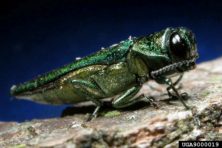Emerald Ash Borer Update
- Share
- Tweet
- Pin
- Share
Last August the Emerald Ash Borer was found in Wisconsin, in Ozaukee County near Newburg. This nuisance beetle has also been located near the state line in Illinois and has recently been found near Escanaba in Upper Michigan. The Wisconsin sightings are at the Riverbend Ecological Center and the other is in the village of Newburg less than a mile away. The surrounding counties that border Ozaukee County have all been placed under quarantine to restrict the spread of the borer. These nasty destroyers were first discovered around the Detroit area in Michigan in 1998 and now infect the neighboring states of Illinois, Indiana, Ohio and Ontario in Canada. The entire state of Illinois is under quarantine.
With 700 Million ash trees of all varieties in Wisconsin, the demise of these trees represents a considerable economic and aesthetic loss. Unfortunately, most infestations can go unnoticed for five years before a tree is decimated. An unusual loss of leaves on the uppermost branches is an indicator of the borer’s presence. Another visible borer indication is a large amount of woodpecker activity on specific healthy looking trees. Epicomic sprouts, which are large green clumps of leaf activity on ash tree trunks at unusual locations, even possibly next to the ground, are indicators. They represent the desperate fight a tree is making to stay alive. Unusual bark cracks in the tree trunk for no visible reason may reveal a borer gallery directly under the bark causing a damaged area to break open.
The life cycle of the Emerald Ash Borer begins with the adults laying eggs during May through August. The larvae remains under the bark for two years as pupae, tunneling in zigzag patterns and cutting off the water and nutrient flow to the upper tree. The adults later emerge through “D” shaped escape holes: flat on one side approximately 1/8” wide. The adult borers forage up to a half-mile, and after the adult flight is over and the eggs are deposited, there is no further spread of the borer during the fall season.
Quarantines dictate that infested trees be removed from infested areas and will likely expand beyond the current half-mile limitation for the removal of all ash trees. The reason being that many trees can now be infected and will not be noticed in the two to three year period before they become obvious hosts.
If you are a woodlot owner, reduce your ash component to less than 20 percent during regular harvesting. Practicing silvaculture, that utilizes trees other than any of the ash species, is a wise choice for future woodlot growth.
Treatment possibilities are not practical for woodlots and are expensive for municipal and privately owned ash trees. Sprays for bark and foliage application, soil drenches and tree injections are the most often used treatments. A treatment with Imidocloprid requires a repeat treatment every one to two years. (Note: This is a restricted use termiticide and you must be a certified applicator to use it.)
For more information call the Emerald Ash Borer Hotline at 1.800.462.2805 or visit http://www.emeraldashborer.wi.gov.


